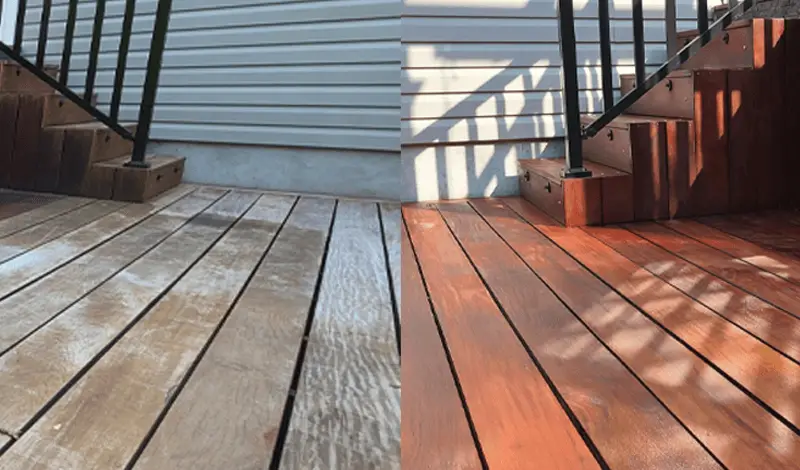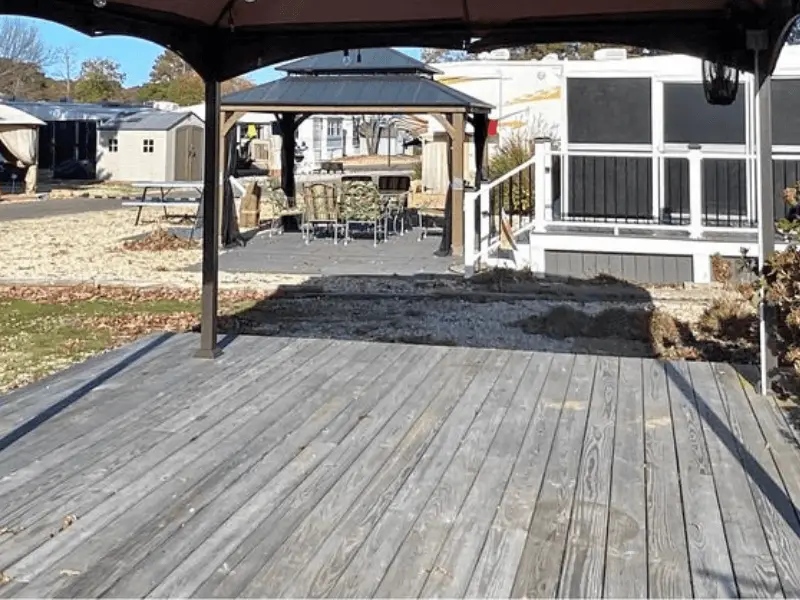Are you tired of looking at your old, dull deck that’s seen better days? Do you want to transform it into a beautiful, vibrant outdoor living space that’ll have your neighbors green with envy? Well, put on your craziest socks and get ready to jump into the world of deck staining and sealing! In this article, we’ll explore the top-rated products that will bring your old deck back to life and make it look brand new again. Whether you’re a seasoned woodworker or just a DIY enthusiast, we’ve got you covered with tips and tricks to help you achieve a flawless finish. So, grab your tools, and let’s dive into the wild world of deck staining and sealing!
Recommended Reading
How to remove solid stain from wood deck
Choosing a deck stain for old decks
Now, before we jump into the best stains and sealers, let’s take a moment to consider what factors you should keep in mind when making your choice. The type of wood, the current condition of the deck, and the desired finish are all important things to consider.
For instance, if you have a cedar or redwood deck, you’ll want to choose a transparent stain that will showcase the natural beauty of the wood. If your deck is in rough shape, you may need a solid stain that will hide imperfections. And if you’re looking for a specific color, you’ll want to choose a stain that offers a range of options. More on these factors later but for now let’s see some products.
Comparison of Top-Rated Stains and Sealers
Now, let’s dive into the top-rated stains and sealers for old decks. We’ve done the research so you don’t have to! Here are our top picks:
Top Pick: Cabot 19202 Cedar Wood Toned Deck and Siding Stain
Cabot 19202 Cedar Wood Toned Deck and Siding Stain is a 1 gal oil-based stain suitable for exterior use. It is a five-liter volume product that can stain decks, fences, or outdoor furniture to achieve a unique translucent opacity. It comes in a range of five colors to choose from. This product is the top pick for several reasons. Keay, among these reasons, is that it can protect against moisture and sunlight.
Pros
- Variety of colors
- Large volume
- Enhances natural wood color
- water repellant
Cons
- Expensive
- Lengthy application and drying times
- Five color varieties are not enough to suit everyone’s needs
Runner’s Up Defy Extreme Wood Stain
DEFY Extreme Wood Stain is an environmentally friendly, water-based semi-transparent wood stain that allows the natural wood grain to shine through with a beautiful matte finish. It is suitable for staining a variety of wood surfaces, including decks, fences, siding, playsets, and outdoor patio furniture. This stain is fortified with zinc nano-particle technology, acting as a protective barrier against damaging UV rays, preventing premature graying and color loss.
Pros
- Environmentally friendly
- Durable
- The best protection against ultraviolet radiation
- Easy to maintain
Cons
- Relatively expensive
Best Budget Deck Semi-Transparent Wood Stain
#1 Deck Premium Semi-Transparent Wood Stain for Decks, Fences, & Siding is a premium water-based stain that comes as one gallon, light walnut wood stain. Two unique features that set this stain aside are that it can be used both as a sealer and as a stain for your deck. Moreover, it is the cheapest among the bunch without compromising on the quality of service.
Pros
- Relatively affordable
- Easy to use and maintain
- Low VOCs
- It can be used on damp wood
Cons
- Poor performance against direct sunlight
- Require frequent maintenance on hardwoods
Types of Stains
Although wood stains come in many variations, understanding a simplified categorization can aid in making informed purchasing decisions. Stains are commonly categorized based on the colorant used, whether pigment or dye, and the presence of a binder, such as oil, lacquer, varnish, or water-based. It is important to note that a single product may contain all three components.
Pigment Stains
This can be considered the general term for most stains. This is because these stains contain the key colorant pigment. However, in most cases, they also contain dyes. All pigment stains contain a binder since pigment cannot penetrate the wood. Therefore a binder is necessary to help it stick to the wood deck. Because these stains cannot penetrate the wood, they are the best choice for protection. Moreover, pigment stains last longer than dye stains since they form a layer over the wood.
Dye Stains
These stains contain dyes as the colorant. Dye dissolves in the liquid so it can penetrate the wood grain. Consequently, binders are not necessary. However, in most instances, dyes are included in stains containing pigments and binders, resulting in the following categories of stains listed below.
Wiping Stains
Almost all stains in the market are wiping stains. The excess can be wiped easily without ruining the deck surface when applied. The composition of these stains is pigment, dye, or both. All contain a binder. The binder can be oil, varnish, or water-based.
Oil Stains
These are stains, whether pigment, dye, or both, that contain oil as the binder.
Water-based Stains
These are stains, whether pigment, dye, or both, that contain a water base as a binder.
Varnish Stains
These are stains, whether pigment, dye, or both, that contain varnish as the binder.
Lacquer Stains
These are stains, whether pigment, dye, or both, that contain an alkyd varnish or lacquer binder that is fast drying. As a result, these stains are the fastest drying. Due to their first drying properties, these stains are sprayed and wiped off fast. They have the quickest application.
Other types of stains you can find in the market include gel stains, Non-grain-raising, chemical stains, and shading stains.
Factors to Consider When Selecting a Stain for Your old Deck

Color
A lot of stains in the market will come in a variety of colors. These colors range from light colors to darker tones. The actual color of the stain is indicated on the actual product, so you won’t have difficulty identifying your favorite color.
Transparency
Another critical aspect is the transparency of the stain. Stains can be transparent, semi-transparent, solid, and semi-solid. Transparent stains are those that allow the natural color through. On the other hand, semi-transparent allows much of the wood color, but one can tell there is a slight shading over them. Semi-solid stains change the wood’s color more than semi-transparent stains, but the natural color is hinted at.
Solid stains change the color completely. Dye stains have better penetrative powers. Therefore, these are better suited for a transparent and semi-transparent look. Pigment stains form layers over the wood grain. Thus are best suited for semi-solid and solid looks.
Durability
Due to their ability to sip into the wood grain, dye stains are the least durable. These fade quickly, especially when used for exterior use. On the other hand, pigment stains form a layer on top of the wood. This layer makes your deck much more durable as it can provide protection against ultraviolet tradition and moisture.
Type of Wood
When it comes to the type of wood, it is crucial to make the right choice of stain. Different types of wood react differently to stains. For instance, soft woods like pine and redwood absorb the stain more, resulting in botching. To avoid this, it is best to use stains that do not sip into the wood grain, such as pigment or gel stains that can coat the wood. Moreover, the state of the surface of your wood matters. Dye stains will penetrate the wood grain so that rougher surfaces will remain rough. However, pigment stains can coat a rough surface as they are non-penetrating. Older woods are more absorbent than new wood.
See Top Picks: Best Sealer for Old Decks
Conclusion
Decks are a beautiful addition to your home. Staining can be an excellent way to enhance their appearance and durability. However, choosing what stain to use can be difficult, leaving you confused. This guide is meant to simplify your choice. It highlights what to look for and suggests three products with excellent qualities to choose from.




